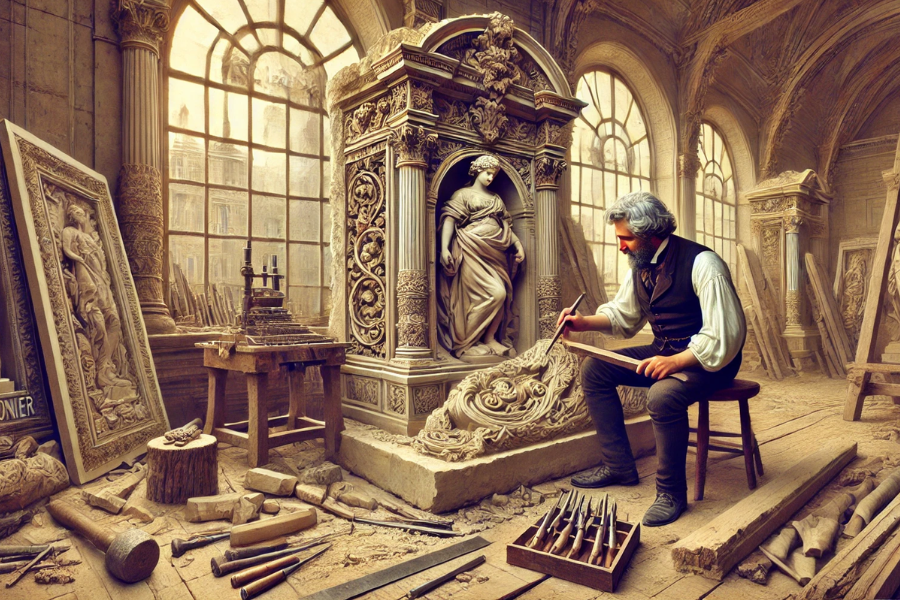
william and tiny aumonier
William and Tiny Aumonier are names that resonate with those who appreciate the fine art of craftsmanship and architectural design. Their contributions to the world of sculpture and design highlight a rich legacy rooted in tradition, skill, and creativity. Let us delve into their fascinating lives, exploring how they shaped their fields and left an indelible mark on the art and architecture community.
William Aumonier: A Journey from Stone to Masterpieces
William Aumonier, born in 1839, came from a lineage steeped in craftsmanship. His father was a stonemason, a trade that William was exposed to from a young age. This early immersion into the world of shaping stone ignited a passion for art and design that would define his career.
Growing up, William observed the intricate process of transforming raw stone into architectural marvels. The sound of chisels against stone and the sight of meticulously carved patterns became a part of his everyday life. These early experiences inspired William to pursue a deeper understanding of sculpture and design, setting him on a path that would lead to remarkable achievements.
Crafting a Reputation
William Aumonier quickly gained recognition for his extraordinary talent. His work combined technical precision with artistic flair, making him a sought-after sculptor and designer. From decorative stone carvings to architectural embellishments, his creations were admired for their elegance and durability.
One of William’s significant contributions was his ability to integrate traditional craftsmanship with modern architectural needs. He worked closely with architects and builders, ensuring that his designs complemented the overall aesthetic of the structures they adorned. This collaborative approach not only showcased his versatility but also established him as a pioneer in blending artistry with practicality.
A Teacher and Mentor
Beyond his creations, William was a mentor to many aspiring artists and craftsmen. He believed in sharing his knowledge and skills, ensuring that the art of stone carving would continue to thrive. His dedication to teaching reflected his deep love for the craft and his commitment to preserving its heritage.
The Artistic Influence of Tiny Aumonier
While William Aumonier’s contributions to craftsmanship are well-documented, the role of Tiny Aumonier, often associated with him, adds another layer to their shared legacy. Though less is known about Tiny, her name frequently appears alongside William’s, suggesting a collaborative relationship that enriched their work.
A Collaborative Dynamic
Tiny Aumonier may have contributed to the artistic and conceptual aspects of their projects. Collaboration in art often involves shared ideas, inspirations, and efforts, and it is plausible that Tiny played a crucial role in the creative processes that underpinned their joint endeavors.
A Symbol of Support
It is also possible that Tiny represented a strong support system for William, allowing him to focus on his craft while managing other aspects of their artistic endeavors. This partnership could have been vital in sustaining their shared vision and ensuring the continuation of their work.
The Aumonier Legacy in Architecture and Design
The contributions of William and Tiny Aumonier are evident in the enduring appeal of their work. Their dedication to craftsmanship has inspired generations of artists and architects, ensuring that their influence remains relevant even in contemporary times.
Bridging Tradition and Modernity
One of the key aspects of their legacy is their ability to bridge traditional techniques with modern demands. At a time when architecture was evolving rapidly, the Aumoniers preserved the essence of classical design while adapting to new trends and technologies.
Contributions to Iconic Structures
Their work can be found in numerous iconic structures, where their meticulous attention to detail enhances the beauty and functionality of the architecture. From ornate facades to intricate interior decorations, the Aumoniers’ contributions are a testament to their unparalleled skill and vision.
Lessons from the Aumonier Legacy
The story of William and Tiny Aumonier offers valuable lessons for today’s artists and craftsmen. Their dedication to their craft, willingness to innovate, and commitment to excellence are qualities that remain relevant across generations.
- The Importance of Skill Development
William’s early exposure to stone masonry highlights the value of learning a craft from its roots. Mastering the basics is essential for achieving greatness in any field. - Collaboration and Teamwork
The partnership between William and Tiny underscores the significance of collaboration in creative endeavors. Combining strengths and ideas can lead to extraordinary outcomes. - Preserving Heritage While Embracing Innovation
The Aumoniers’ ability to adapt traditional techniques to modern architecture is a reminder of the importance of balancing heritage with progress. - Mentorship and Teaching
William’s role as a mentor emphasizes the responsibility of experienced professionals to nurture the next generation, ensuring the continuity of their craft.
Honoring Their Contributions
Today, the legacy of William and Tiny Aumonier lives on in the timeless beauty of their creations. Their work serves as a reminder of the transformative power of art and craftsmanship. By honoring their contributions, we celebrate not only their individual achievements but also the rich traditions they represent.
For art and architecture enthusiasts, studying the lives and works of the Aumoniers provides a deeper appreciation of the effort and creativity involved in shaping our built environment. Their story is an inspiration for all who strive to leave a lasting impact through their work.
Conclusion
The lives of William and Tiny Aumonier reflect a dedication to craftsmanship, artistry, and innovation that continues to inspire. From their meticulous stone carvings to their influence on architectural design, their legacy is a beacon for those who value the intersection of tradition and creativity.
As we admire the structures adorned by their work, we are reminded of the enduring power of art to shape not only physical spaces but also the cultural and historical narratives of our world. The Aumoniers’ story is one of passion, perseverance, and partnership—an enduring testament to the beauty of human creativity.
Explore the Latest Insights and Discussions at ventswired.



